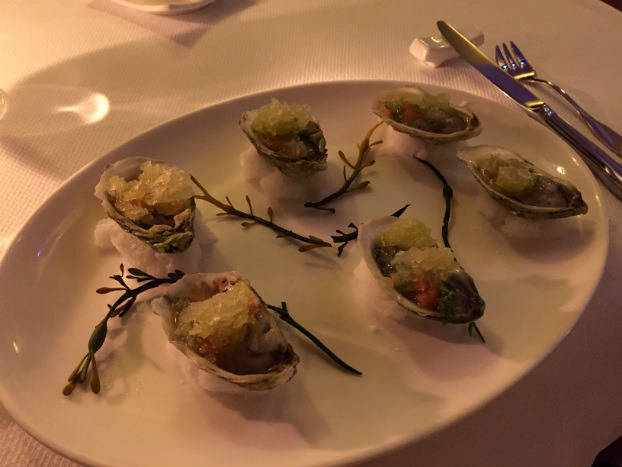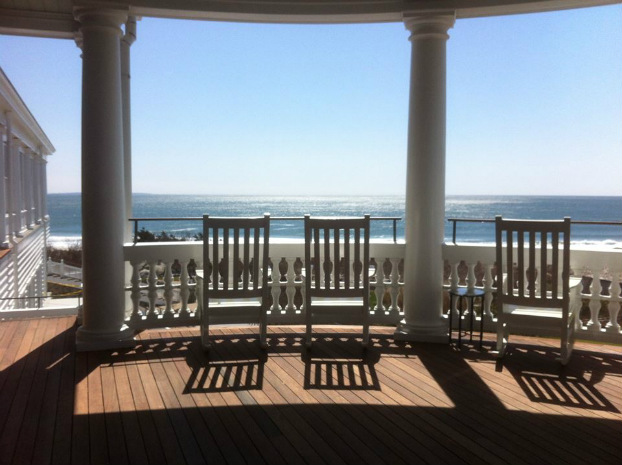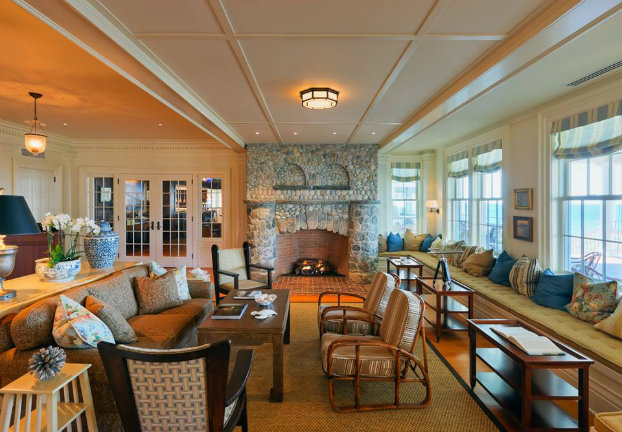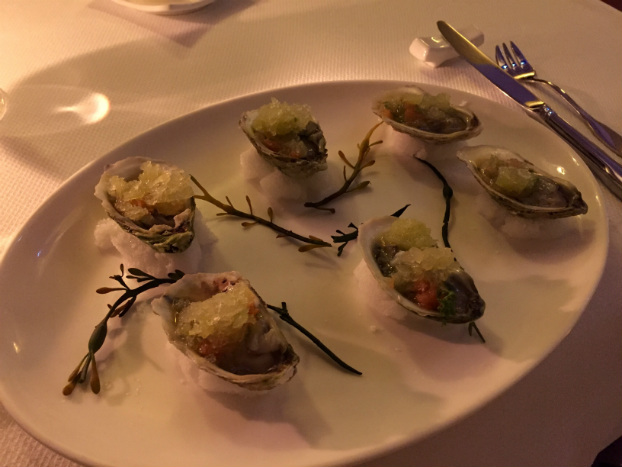Ocean House: Where Past Meets Present
While driving down the winding streets of Westerly, Rhode Island towards the historic Watch Hill district my copilot, Kate Kolenda, decided to put on a song I had never heard before called, New England, by Jonathan Richman & The Modern Lovers. It's the kind of song that feels like it's frozen in a certain moment in time, and has the ability to transport you back to that moment. As we passed through the picturesque New England landscapes dotted with mansard roofs and farms, we rounded a corner and the Ocean House resort erupted into view in all its majesty and grandeur, and it was in that moment that I realized we were about to be transported to another moment in time.
We pulled up to the entrance and were whisked away towards the lobby as the smiling and cordial valet and other attendants took our bags and belongings up to the room. The white staircase leading to the front doors turns into a wrap-around veranda where, during the warmer months, guests can enjoy a casual meal in the sunshine.
Stepping inside Ocean House is like traveling back in time to the Gilded Age itself. Originally built in 1868, Ocean House's story is one of resilience. It now stands pale yellow and obstinate against the harsh Atlantic, the only hotel from the Gilded Age on Watch Hill to survive seasonal hurricanes and catastrophic fires, but it nearly succumbed to the elements. Ocean House was once the kind of place where one might attend teatime after a morning out on the yacht, where the silent film classic American Aristocracy starring Douglas Fairbanks was filmed in 1916, but by the early-2000s the building had fallen into such disrepair that it could not feasibly be brought up to modern safety codes.
Then, in 2004, a developer bought the property with plans to demolish and build several oceanfront homes, but the residents of Watch Hill rose up, and in an early display of crowd sourcing they banded together and saved the property from the threat of McMansions. The fact remained, however, that the building could not be preserved. An outside consultant concluded that the only way to save Ocean House would be to tear it down and replicate the original by rebuilding with modern materials and techniques. And so they did.
Every little detail and dimension was documented then replicated, and as much of the original building that could be saved has been reused. The modern Ocean House features many of the same fixtures that adorned the demolished hotel, and even the original oak-paneled elevator was saved and brought up to code. The floorboards are made of softer pinewood that was chosen because it would show signs of age and wear more rapidly than a stronger hardwood. The well-worn reception desk is also original, as are the beautiful handles on the outer doors of the building, but the most impressive feat of preservation-through-replication is the enormous stone fireplace that sits between the living room and the Bistro; every single stone was numbered and countless photos were taken so the fireplace could be dismantled then reassembled with the new construction. The first rebuild wasn't accurate enough though, and the new owners had the builders dismantle and reassemble the fireplace a second time, which gives just a small idea of how detail-oriented the rebuilding process was.
The stunning design and architecture of the hotel would be sufficient to transport guests back in time to a Victorian summer, but Ocean House ups the ante with a breathtaking collection of rotating art installations that adorn the walls of hallways and common areas. During our stay the ground floor and downstairs area were decked out in paintings, sketches and illustrations by Ludwig Bemelmans, including many of his most famous creation Madeline, and caricatures by Sem of socialites and celebrities from French high society in the early 20th century lined the walls of the hallway where our room was located. I actually found myself so engrossed by each one that before I knew it thirty minutes had gone by, so block out some time for art appreciation when you visit. The pieces curated by Ocean House reinforced the idea of time travel with subtlety, gently suggesting the era they were born in without being heavy-handed about it.
The most wonderful thing about Ocean House is that it whisks you away to a different time while offering all the best amenities that modernity has to offer. The Ocean House is the only AAA Five Diamond and Forbes Five-Star hotel in Rhode Island, and both the OH! Spa and Seasons restaurant are also Forbes Five Star rated, making it one of only 10 resorts in the world with a triple Forbes Five Star rating. Ocean House is also a member of the prestigious Relais & Châteaux, a fellowship of individually owned restaurants and hotels that sets the gold standard for unique, high-end, venues around the world. The accolades Ocean House has won are well deserved, as the impeccably trained staff and thoughtful accommodations leave absolutely nothing to be desired.
The Center for Wine and Culinary Arts is another elegant example of past meeting present at Ocean House. The Center was completed in late 2015 and offers guests an intimate place to taste, create, and explore food and wine in a 3000 square foot space where sommelier Gregory Astudillo and Food Forager Paul McComiskey lead daily classes. The food classes generally revolve around the seasonal agricultural bounties of New England whereas the wine classes take advantage of the Wine Spectator Award-winning 8000-bottle wine collection beautifully displayed in two stunning cellars right inside the Center. The classes all boast an unpretentious approachability for expert and novice alike. The gorgeous kitchen and entertaining space inside the Center for Wine and Culinary arts was built with a mix of state of the art appliances by Gaggenau and reclaimed wood from a 19th Century Connecticut tobacco barn, again blending past and present in that signature Ocean House style.
Guests looking for an exemplary culinary experience will not be disappointed. The Seasons restaurant at Ocean House, which overlooks the Atlantic coast, offers an outstanding farm to table menu of seasonal and sustainable New England cuisine. Guests can choose between three or four courses, and can have their meal paired with an exquisite bottle of wine selected by sommelier Gregory Astudillo. Guests looking for a truly special experience can opt to sit at the chef's counter where chef Jacob Jasinski prepares and then serves an exquisite eight-course meal before their very eyes. [pullquote:right]
I opted for the tobacco-smoked rabbit with ravioli and brown butter emulsion to start, which was delicate and not at all gamey. We also shared oysters on the half shell topped with a green tomato granité, spicy radish, and finger lime, which are sourced from a local oyster farm whose owner told the Seasons that their preparation was the absolute best he has ever had, and I have to agree with him.
Our small plates were followed by an exquisite but not overly rich combination of truffled risotto with uni and piave vecchio, and a dish of beef two ways that incorporated beef cheek, ribeye steak, caramelized onions and marrow.
Dessert included single origin chocolate from Ecuador served as a terrine with pistachio praline, salted pistachio sorbet, meringue, and lemon curd, and an orange soufflé with mint crème anglaise and cranberry sorbet.
Every bite of every course at the Seasons was perfectly balanced and perfectly executed, and the dishes were satisfying without being too heavy. From the cocktails to the wine to the food, the staff at the Seasons delivered at every turn and demonstrated why they are a Forbes five-star restaurant.
By the end of the weekend we found ourselves wishing we had more time to spend at Ocean House and making plans to come back. A visit to the resort transports the guest to a different era, one of white gloves and top hats, and our trip back in time ended too abruptly. The grandeur and majesty of Ocean House and the attentive hospitality of its staff are something that, once experienced, will never be forgotten.
Additional reporting by Kate Kolenda.



